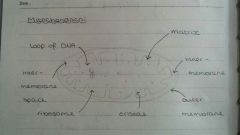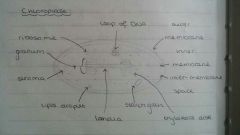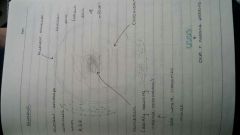![]()
![]()
![]()
Use LEFT and RIGHT arrow keys to navigate between flashcards;
Use UP and DOWN arrow keys to flip the card;
H to show hint;
A reads text to speech;
11 Cards in this Set
- Front
- Back
|
Eukaryotic |
True nucleus |
|
|
Prokaryotic |
No true nucleus |
|
|
Flagella undulipodia |
Few and long in length 1200 um |
|
|
Cilla |
Many and short in length, move in a wave like motion (10 um) eg moving nucleus-ciliated epithelium. Contain microtubules 9 pairs in a circle, 2 form a central bundle "9+2" arrangement Slide past each other (energy from ATP) |
|
|
Cytoskeleton |
Network of protein fibres & microtubules found within the cell - gives structure & responsible for movement of many materials |
|
|
Describe the structure of mitochondria |

|
|
|
Describe the structure of chlorplasts |

|
|
|
Roles of cytoskeleton |
-Provides support to cell -Moves membrane for endo/exocytosis -Movement of organelles/ vesicles -Movement of flagella/ cilia (create a current) -Make up centrioles/ spindle fibres |
|
|
Features of prokaryotic cells |
-No true nucleus/ membrane bound organelles -Loose strands of DNA in cytoplasm -Circular DNA -Smaller ribosomes (18nm/70s) -Peptidoglycan cell wall -Smaller diameter (0.5/5um) -Flagellum -Plasmids |
|
|
Features of eukaryotic cells |
-True nucleus -DNA in nucleus-around histone proteins -Linear DNA Larger ribosomes (22nm/80S) -Cellulose/chitin cell wall -Larger diameter (20 - 40 um) -Cilia -No plasmids |
|
|
Describe the structure of the nucleus |

|

